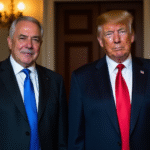Background on Key Players and Relevance
The United States-Mexico-Canada Agreement (T-MEC) consultations have begun, focusing on assessing the agreement’s performance before trilateral review work starts in 2023. Meanwhile, former U.S. President Donald Trump continues his tariff-focused “war,” pushing Mexico to eliminate more than 50 non-tariff barriers, a condition reaffirmed by Senator Marco Rubio during his recent visit to Mexico.
Non-Tariff Barriers Requiring Immediate Attention
Although there is no public list, the USTR report from March outlines key non-tariff barriers that need elimination. These include:
- Prohibitions on genetically modified organisms, such as glyphosate and transgenic corn;
- Barriers to intellectual property protection, including protectionism for films, piracy, and counterfeiting;
- Ensuring non-discriminatory treatment for U.S. companies and investors in the energy sector, similar to PEMEX and CFE;
- Addressing high radio-electric spectrum costs, one of the most expensive in the world, under telecommunications;
- Reducing COFEPRIS’s license importation processing time from 18 to 24 months;
- Limitations and regulatory uncertainty for foreign direct investment.
Addressing these barriers is crucial, as it ultimately benefits Mexico by fostering greater competition and productivity.
Reciprocal Commitments and Their Impact
Mexico has committed to removing these barriers, but the U.S. must follow through on eliminating recent tariffs in the automotive sector, steel, aluminum, and copper, as well as new tariffs on heavy trucks, furniture, and pharmaceuticals. This reciprocal commitment is essential for the T-MEC’s success.
Trump’s Tariff Focus and T-MEC’s Future
Despite Trump’s political use of trade tools and tariffs as a weapon, the U.S. recognizes the importance of the T-MEC’s trilateral commerce. Abandoning the agreement is unlikely, as the U.S. sees the T-MEC as an effective integration block to counter China’s commercial might. Mexico must confront Chinese trade, but not by imposing high tariffs on Chinese products, as recently decreed.
Key Questions and Answers
- What are the main non-tariff barriers that need immediate removal? Key barriers include prohibitions on genetically modified organisms, intellectual property protection issues, non-discriminatory treatment for U.S. energy companies, high radio-electric spectrum costs, lengthy import license processing times by COFEPRIS, and regulatory limitations for foreign direct investment.
- Why is addressing these barriers important for Mexico? Removing these obstacles promotes greater competition and productivity, ultimately benefiting Mexico.
- What commitments have the U.S. and Mexico made regarding tariffs? The U.S. has pushed for the elimination of over 50 non-tariff barriers in Mexico, while Mexico has committed to removing recent tariffs in various sectors. In return, the U.S. must eliminate tariffs in automotive, steel, aluminum, copper, heavy trucks, furniture, and pharmaceutical sectors.
- Why is the T-MEC significant for the U.S., despite its protectionist tendencies? The U.S. recognizes the T-MEC’s value in fostering trilateral commerce and countering China’s commercial power. Abandoning the agreement is unlikely, as it serves as an effective integration block.






